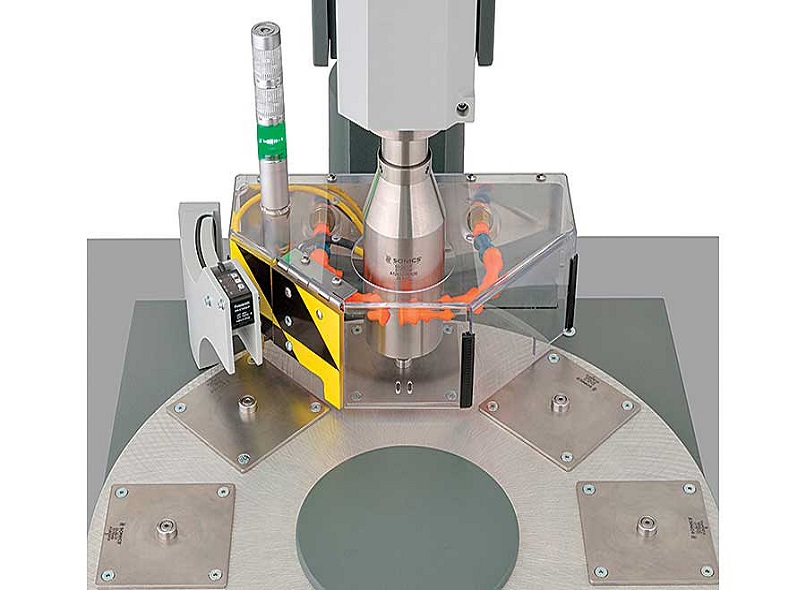Ultrasonic Welding Lighter: Revolutionizing Manufacturing and Assembly Processes

In the world of intelligent manufacturing and automation, one technology stands out for its ability to join materials with precision and efficiency - Ultrasonic Welding. This innovative process, characterized by the application of high-frequency ultrasonic acoustic vibrations, has revolutionized various industries, including the production of lighters. By utilizing the principles of ultrasonic welding, manufacturers can create lighter kits, assemble components, and ensure the highest quality finished products.
Understanding Ultrasonic Welding
Ultrasonic welding is a solid-state joining process that utilizes high-frequency ultrasonic vibrations to create a solid-state weld between two workpieces. It is commonly used for joining plastics and metals, allowing the fabrication of intricate and precise components without the need for additional fasteners or adhesives. What sets ultrasonic welding apart is its ability to join dissimilar materials, opening up a world of possibilities for manufacturers.
History of Ultrasonic Welding
The origins of ultrasonic welding can be traced back to the 1960s when the practical application of joining rigid plastics was first achieved. The patent for the ultrasonic method of welding rigid thermoplastic parts was awarded to Robert Soloff and Seymour Linsley in 1965. Soloff, a lab manager at Branson Instruments, made a serendipitous discovery while working with ultrasonic probes. He observed that the halves of a plastic tape dispenser welded together when the probe was unintentionally placed close to it. This revelation led to the development of the first ultrasonic press and the subsequent application of ultrasonic welding in various industries.
The Ultrasonic Welding Process
The process of ultrasonic welding involves several key components working in harmony to create a strong and reliable bond. These components include:
- Press: A press, powered by either pneumatic or electric means, applies pressure to hold the workpieces together during welding.
- Anvil or Fixture: The workpieces are placed between an anvil or fixture, which directs the high-frequency vibration to the interfaces for welding.
- Ultrasonic Stack: The ultrasonic stack consists of a converter or piezoelectric transducer, a booster (optional), and a horn or sonotrode. These elements are specifically tuned to resonate at the same ultrasonic frequency, typically ranging from 15 kHz to 70 kHz.
- Electronic Ultrasonic Generator: The generator delivers a high-power electric signal at the resonant frequency of the ultrasonic stack, providing the necessary energy for welding.
- Controller: The controller manages the movement of the press and the delivery of ultrasonic energy, ensuring precise and controlled welding.
The combination of these components enables the generation of high-frequency vibrations that create localized melting or bonding of the workpiece materials. The result is a solid-state weld that is clean, precise, and durable.
Advantages of Ultrasonic Welding
Ultrasonic welding offers numerous advantages over traditional joining methods, making it a preferred choice for manufacturers in various industries. Some of the key advantages include:
- Low Thermal Impact: Ultrasonic welding operates at temperatures below the melting point of the materials involved, minimizing the risk of thermal damage or distortion. This is particularly important when joining metals, as it allows for precise control and prevents unwanted changes in material properties.
- Fast and Efficient: The ultrasonic welding process is incredibly fast, with weld times ranging from fractions of a second to a few seconds. This high-speed operation enables manufacturers to achieve efficient production rates while maintaining consistent quality.
- No Additional Materials: Unlike traditional welding techniques that require additional fasteners, adhesives, or soldering materials, ultrasonic welding eliminates the need for any connective elements. This not only streamlines the manufacturing process but also reduces material costs and simplifies product design.
- Versatility: Ultrasonic welding can join a wide range of materials, including plastics, metals, and even dissimilar combinations. This versatility opens up new possibilities for product design and enables the creation of complex and lightweight components.
- Clean and Aesthetic Joints: Ultrasonic welding produces clean and aesthetically pleasing joints, eliminating the need for additional finishing or touch-up work. The welds are precise, with minimal flash or excess material, resulting in visually appealing finished products.
- Automation and Integration: The ultrasonic welding process can be easily automated, making it ideal for integration into production lines. The use of programmable controllers and data interfaces allows for seamless coordination with other manufacturing processes, ensuring efficient and synchronized operations.
These advantages have propelled ultrasonic welding into various industries, including automotive, electronics, medical devices, and consumer goods. In the next sections, we will delve deeper into the application of ultrasonic welding in specific industries, with a focus on the production of lighters.
Ultrasonic Welding in the Automotive Industry
The automotive industry has been a major adopter of ultrasonic welding technology, leveraging its benefits for both structural and aesthetic applications. Ultrasonic welding is commonly used in the assembly of various components, such as interior trim panels, door panels, instrument clusters, and even lightweight body panels.
Structural Integrity and Weight Reduction
In automotive manufacturing, ensuring structural integrity while minimizing weight is crucial. Ultrasonic welding allows for the joining of lightweight materials, such as aluminum and carbon fiber-reinforced polymers (CFRPs), without compromising strength. By utilizing ultrasonic welding, automakers can achieve significant weight reduction, leading to improved fuel efficiency and overall vehicle performance.
Aesthetic and Functional Joining
Ultrasonic welding is also employed in the assembly of interior components, where both aesthetic appeal and functional performance are essential. For example, ultrasonic welding is used to join plastic parts of the dashboard, center console, and door panels, creating seamless and visually appealing joints. Additionally, ultrasonic welding can be utilized to integrate functional features, such as connectors, sensors, and switches, directly into the components, eliminating the need for additional assembly steps.
Precision and Efficiency
In the highly automated automotive industry, precision and efficiency are paramount. Ultrasonic welding, with its fast cycle times and high repeatability, meets these requirements effectively. The ability to programmatically control welding parameters and store multiple welding programs allows for seamless integration into production lines, ensuring consistent quality and improved productivity.
Ultrasonic Welding in the Electronics Industry
In the electronics industry, where small and intricate components are the norm, ultrasonic welding plays a critical role in ensuring reliable connections and efficient assembly processes. From the production of consumer electronics to the manufacturing of medical devices, ultrasonic welding offers unique advantages for joining plastic and metal parts.
Lighter Manufacturing: The Role of Ultrasonic Welding
Lighters are a ubiquitous everyday item, and their production requires precise assembly techniques. Ultrasonic welding has become an essential process in the manufacturing of lighters, enabling the efficient and reliable assembly of various components.
The process of ultrasonic welding in lighter manufacturing involves the use of specialized equipment designed to handle the specific requirements of lighter assembly. This equipment includes lighter kit installation machines, microcomputer automatic lighters, and full-automatic production lines.
With ultrasonic welding, lighter components, such as the ignition mechanism, gas valve assembly, and body, can be securely joined together without the need for additional adhesives or fasteners. The high-frequency vibrations generated by the ultrasonic welding equipment create localized melting or bonding, resulting in strong and durable connections.
Benefits of Ultrasonic Welding in Lighter Manufacturing
The utilization of ultrasonic welding in lighter manufacturing offers several key benefits:
- Speed and Efficiency: Ultrasonic welding allows for fast and efficient assembly of lighter components. With cycle times ranging from fractions of a second to a few seconds, manufacturers can achieve high production rates without compromising quality.
- Strength and Durability: The solid-state welds created through ultrasonic welding are highly durable, ensuring that the assembled lighters withstand the rigors of everyday use. The joints are strong, resistant to vibration, and capable of maintaining their integrity over time.
- Aesthetic Appeal: Ultrasonic welding produces clean and aesthetically pleasing joints, enhancing the overall appearance of the finished lighters. The absence of additional adhesives or fasteners creates a seamless and visually appealing product.
- Simplified Assembly: Ultrasonic welding eliminates the need for additional assembly steps, such as applying adhesives or fastening components with screws or bolts. This simplifies the manufacturing process, reduces the risk of errors, and improves overall efficiency.
- Cost Savings: By removing the need for additional materials, such as adhesives or fasteners, ultrasonic welding reduces material costs and streamlines the production process. Manufacturers can achieve higher productivity and cost savings while maintaining the highest standards of quality.
The application of ultrasonic welding in lighter manufacturing exemplifies the versatility and capabilities of this advanced joining process. Whether in the automotive, electronics, or other industries, ultrasonic welding continues to drive innovation, enabling manufacturers to create lighter, stronger, and more aesthetically appealing products.
Conclusion
Ultrasonic welding has emerged as a game-changing technology in the manufacturing and assembly processes. Its ability to join a wide range of materials, including plastics and metals, has revolutionized various industries, including the production of lighters. By harnessing the power of high-frequency ultrasonic vibrations, manufacturers can achieve precise and durable connections without the need for additional materials or complex assembly techniques.
From automotive structural components to consumer electronics and everyday items like lighters, ultrasonic welding offers numerous advantages. Its low thermal impact, fast cycle times, and seamless integration into automated production lines make it a preferred choice for manufacturers seeking efficiency, reliability, and cost savings.
As manufacturing continues to evolve, ultrasonic welding will undoubtedly play a pivotal role in driving innovation and shaping the future of intelligent manufacturing. By embracing this advanced joining process, manufacturers can unlock new possibilities, improve product quality, and deliver exceptional products to consumers worldwide.
See more ultrasonic welding troubleshooting





